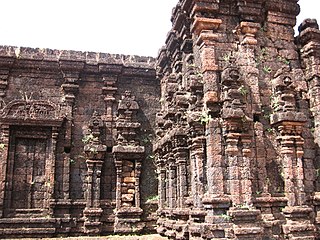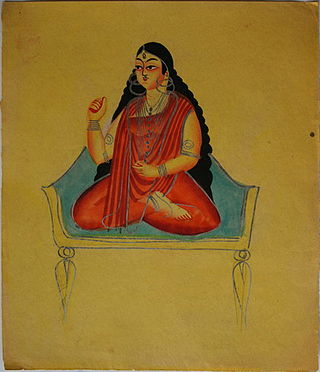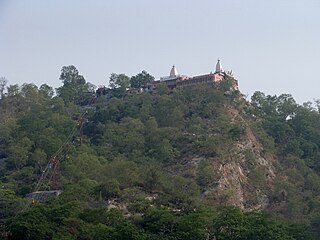
Kartika Deepam is a festival of lights that is observed mainly by Hindu Tamils, and also by adherents in the regions of Kerala, Andhra Pradesh, Telangana, Karnataka, and Sri Lanka. Celebrated in Tamilakam since the ancient period, the festival is held on the full moon day of the Kartika (கார்த்திகை) month, called the Kartika Pournami, falling on the Gregorian months of November or December. It is marked on the day the full moon is in conjunction with the constellation of Kartika. It corresponds to the occasion of the Kartika Purnima, though it falls on a different day due to the correction of equinoxes in the Tamil calendar.

Nalbari is an administrative district in the state of Assam in India. The district headquarters is located at Nalbari.

Kamakhya, a mother goddess, is a Shakta Tantric deity; considered to be the embodiment of Kama (desire), she is regarded as the goddess of desire. Her abode–Kamakhya Temple is located in the Kamarupa region of Assam, India. Originally a Kirata goddess, Kamakhya remained outside Brahmanical influence until at least 7th century CE. Residing on Nilachal hills across the banks of the Brahmaputra river, west of Guwahati in the 10th/11th century Temple rebuilt in 1565 CE, she is worshiped in a non-iconic and un-anthropomorphic form of stone shaped like yoni fed by a perennial stream. The temple is primary amongst the 51 Shakti Peethas, and is one of the most important Shakta temples.

The Rajarajeshwara temple is a Shiva temple located in Taliparamba in Kannur district of Kerala, India. The temple is regarded as one of the existing 108 ancient Shiva Temples of ancient Kerala. It also has a prominent place amongst the numerous Shiva temples in South India. It had the tallest shikhara amongst the temples of its time. The Rajarajeshwara temple has a top of about 90 tonnes. If any problem is encountered in the other temples of South India, devotees seek a solution in this temple through a prashnam, a traditional method of astrological decision-making. The prashnam is conducted on a peedha outside the temple.

Rupandehi District, a part of Lumbini Province, is one of the seventy-seven districts of Nepal and covers an area of 1,360 km2 (530 sq mi). The district headquarter is Bhairahawa. As per the national census 2011, the population of Rupandehi was 880,196.

Nalbari is a town and a municipal board in Nalbari district in the Indian state of Assam. Nalbari town is also the headquarters of Nalbari District. The town is one of many towns covered under the proposed State capital region.
Ambaji (Ambājī) is a census town in Banaskantha district in the state of Gujarat, India. It is known for its historical connections with sites of cultural heritage.
Biswanath Chariali is a city and a municipal board in Biswanath district in the state of Assam, India. This city is the district headquarters of Biswanath district, which was created on 15 August 2015. It derives its name from Biswanath Ghat.

Suremphaa, or Rajeswar Singha, the fourth son of Rudra Singha, became the king of the Ahom kingdom after the death of his brother King Pramatta Singha. Rudra Singha's third son, Mohanmala Maladev Gohain, was considered ineligible for kingship as his face was pitted with smallpox marks. According to the norm established after Sulikphaa Lora Roja, an Ahom prince had to be free from any physical disability, defects or deformities to become a king.

Assam is the main and oldest state in the North-East Region of India and as the gateway to the rest of the Seven Sister States. The land of red river and blue hills, Assam comprises three main geographical areas: the Brahmaputra Valley which stretching along the length of the Brahmaputra river, the Barak Valley extending like a tail, and the intervening Karbi Plateau and North Cachar Hills. Assam shares its border with Meghalaya, Arunachal Pradesh, Nagaland, Manipur, Tripura, Mizoram and West Bengal; and there are National Highways leading to their capital cities. It also shares international borders with Bhutan and Bangladesh and is very close to Myanmar. In ancient times Assam was known as Pragjyotisha or Pragjyotishpura, and Kamarupa.
Batsor, also Batshar and Batchar is a village in Nalbari district of the Indian state of Western Assam. It is surrounded by Belsor, Churchuri and Goalpara.

Kartika Purnima is a Hindu, Sikh and Jain cultural festival that is celebrated on Purnima, the 15th lunar day of the month of Kartika. It falls in November or December of the Gregorian calendar and is also known as Tripurari Purnima or Deva-Deepawali, the gods' festival of lights. Karthika Deepam is a related festival that is celebrated in South India and Sri Lanka on a different date.
Tokha Chandeshwari is a village and former Village Development Committee that is now part of Tokha Municipality in Kathmandu District in Province No. 3 of central Nepal. At the time of the 2011 Nepal census it had a population of 3,961. Tokha Chandeshwari now is part of Tokha municipality.
Sri Vasudevapuram Temple is one of three ancient temples on the Southern bank of holy river Bharathapuzha. It sits east of the other two, Maha Siva Temple and Brahma temple. These temples along with the famous Thirunavaya Maha Vishnu temple across the river form the trilogy in Sanatana Dharma). Tavanur is called Muvaankara (മൂവ്വാങ്കര). Brahma, Vishnu and Shiva are the presiding deities, so it was initially known as Muvalankara, and then Muvaankara.

Bhuvaneshvari is a Hindu goddess. She is the fourth amongst the ten Mahavidya goddesses in Shaktism, and one of the highest aspects of Mahadevi. She is identified as Adi Parashakti in the Devi Bhagavatam.

Mansa Devi Temple, Haridwar is a Hindu temple dedicated to goddess Mansa Devi in the holy city of Haridwar in the Uttarakhand state of India. The temple is located atop the Bilwa Parvat on the Sivalik Hills, the southernmost mountain chain of the Himalayas. The temple, also known as Bilwa Tirth is one of the Panch Tirth within Haridwar.

Dirgheswari Mandir is a temple situated in the northern banks of the river Brahmaputra in Guwahati, Assam,India. Many ancient images made on rocks existed along with the temple. Brick temple was Built by Ahom king Swargadeo Siva Singha, Dirgheswari temple is considered as a Shakti Peetha for Shakti Worship. The main attraction of Dirgheswari temple is the annual Durga Puja celebrations, in which devotees from far of places use to attend.

Vaikuntha Chaturdashi is a Hindu holy day, which is observed on chaturdashi, the 14th lunar day of the waxing moon fortnight of the Hindu month of Kartika (November–December). The day is sacred to the deities Vishnu and Shiva. They are worshipped individually or together in different temples in Varanasi, Rishikesh, Gaya, and Maharashtra.
Kaliya Nayanar, also known as Kalia Nayanar, Kalia, Kaliya, Kaliyanar and Kaliyar, is a Nayanar saint, venerated in the Hindu sect of Shaivism. He is generally counted as the forty-fourth in the list of 63 Nayanars. The Nayanar saint is described to serve the god Shiva by lighting lamps in his Thyagaraja Temple. He is said to have been willing to cut his throat to fill the lamps with his blood, when he ran out of oil.
Thawe Mandir, the Temple of Maa Thawewali is situated in Thawe, in Gopalganj District in the State of Bihar, India. It is only 6 km from Gopalganj town on the Gopalganj-Siwan National Highway.














